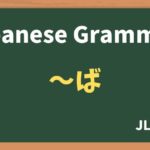
Contents
1. What is the Conditional Form(ば形)?
The Conditional Form(ば形) is used to describe conditions or hypothetical scenarios. It’s similar to the English “if” and “when,” and is helpful for expressing the outcomes of particular situations.
2. How to Form the Conditional Form
The method for forming the conditional form varies by verb group. Here’s how to create it from both the dictionary form and the ます form, for those who may have learned the polite form first.
From the Dictionary Form:
- Group 1 (U-Verbs):
- Replace the final "u" sound with the corresponding “e” sound + ば.
- Examples:
- いく → いけば (if [someone] goes)
- かく → かけば (if [someone] writes)
- はなす → はなせば (if [someone] speaks)
- Group 2 (RU-Verbs):
- Replace る with れば.
- Examples:
- たべる → たべれば (if [someone] eats)
- みる → みれば (if [someone] sees)
- Group 3 (Irregular Verbs):
- する becomes すれば (if [someone] does).
- くる becomes くれば (if [someone] comes).
From the ます Form:
- Group 1 (U-Verbs):
- Remove ます and change the “i” sound before ます to the corresponding “e” sound + ば.
- Examples:
- いきます → いけば (if [someone] goes)
- かきます → かけば (if [someone] writes)
- はなします → はなせば (if [someone] speaks)
- Group 2 (RU-Verbs):
- Remove ます and add れば.
- Examples:
- たべます → たべれば (if [someone] eats)
- みます → みれば (if [someone] sees)
- Group 3 (Irregular Verbs):
- します becomes すれば (if [someone] does).
- きます becomes くれば (if [someone] comes).
Using both methods allows learners who began with the polite form to recognize the pattern and convert verbs into the conditional form accurately.
3. Sample Sentences
Here are some sample sentences showing how the conditional form is used in various contexts:
- Group 1 (U-Verbs):
- いけば (if [someone] goes): あす いけば、かれに あえます。
(If you go tomorrow, you can meet him.) - かけば (if [someone] writes): メールを かけば、すぐに へんじが もらえます。
(If you write an email, you’ll get a reply quickly.)
- いけば (if [someone] goes): あす いけば、かれに あえます。
- Group 2 (RU-Verbs):
- たべれば (if [someone] eats): やさいを たべれば、もっと げんきになりますよ。
(If you eat vegetables, you’ll feel more energetic.) - みれば (if [someone] sees): この えいがを みれば、にほんの ぶんか がよくわかります。
(If you watch this movie, you’ll understand Japanese culture better.)
- たべれば (if [someone] eats): やさいを たべれば、もっと げんきになりますよ。
- Group 3 (Irregular Verbs):
- すれば (if [someone] does): もっと れんしゅうすれば、じょうずになります。
(If you practice more, you’ll get better.) - くれば (if [someone] comes): ここに くれば、とくべつな けしきが みられます。
(If you come here, you can see a special view.)
- すれば (if [someone] does): もっと れんしゅうすれば、じょうずになります。
4. Common Uses of the Conditional Form
The conditional form is used widely in Japanese for expressing various hypothetical situations, conditions, and logical sequences:
- Expressing Possible Outcomes or Results:
Used to discuss likely results of an action or condition.- Example: いっしょうけんめい べんきょうすれば、しけんに ごうかくできます。
(If you study hard, you can pass the exam.)
- Example: いっしょうけんめい べんきょうすれば、しけんに ごうかくできます。
- Giving Advice or Suggestions:
Commonly used to make suggestions about what one should do under certain conditions.- Example: おかねが たりなければ、わたしに そうだんしてください。
(If you don't have enough money, please let me know.)
- Example: おかねが たりなければ、わたしに そうだんしてください。
- Hypothetical Situations:
Often used to talk about potential scenarios or hypothetical events.- Example: てんきが よければ、でかけましょう。
(If the weather is good, let’s go out.)
- Example: てんきが よければ、でかけましょう。







